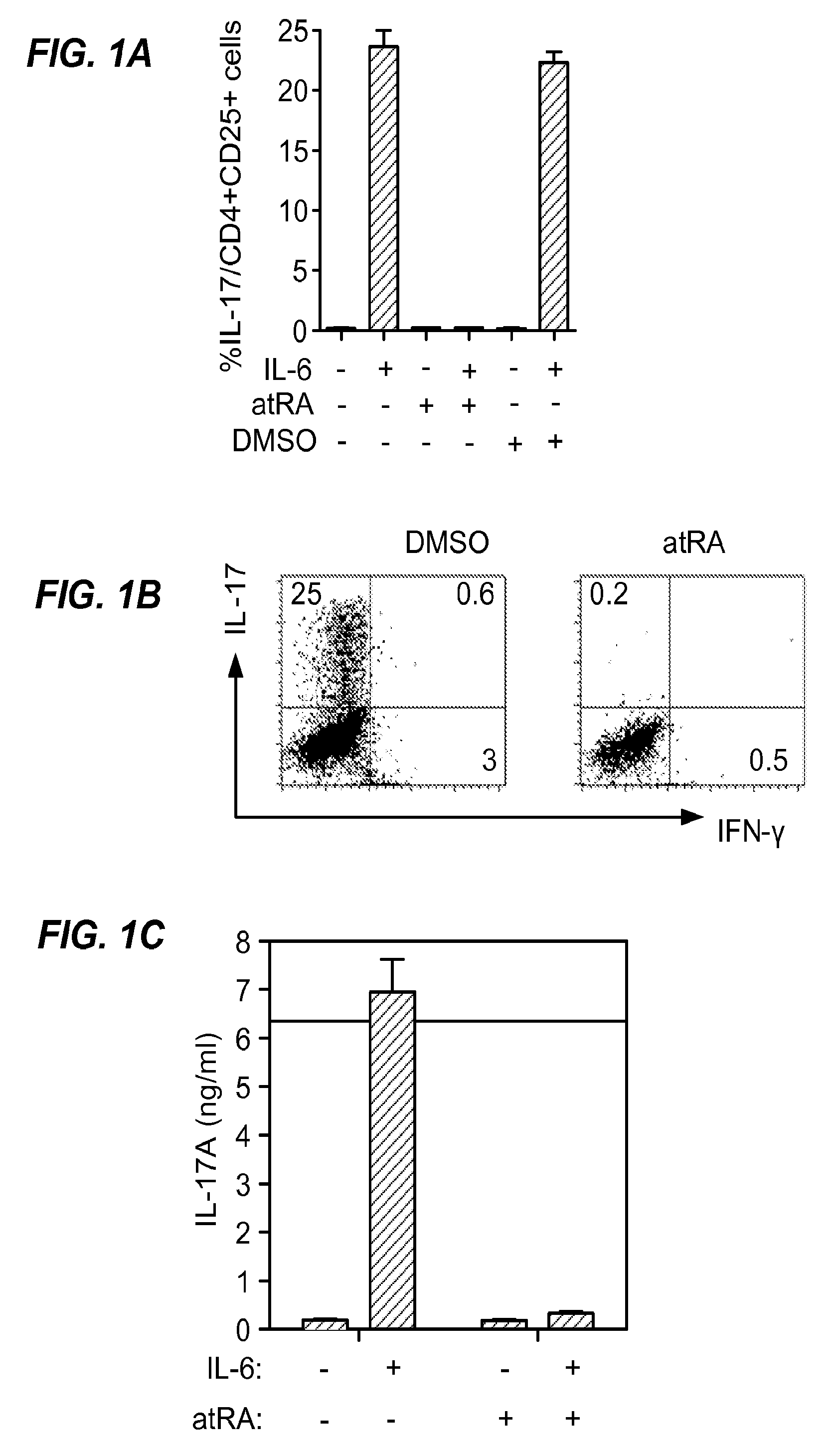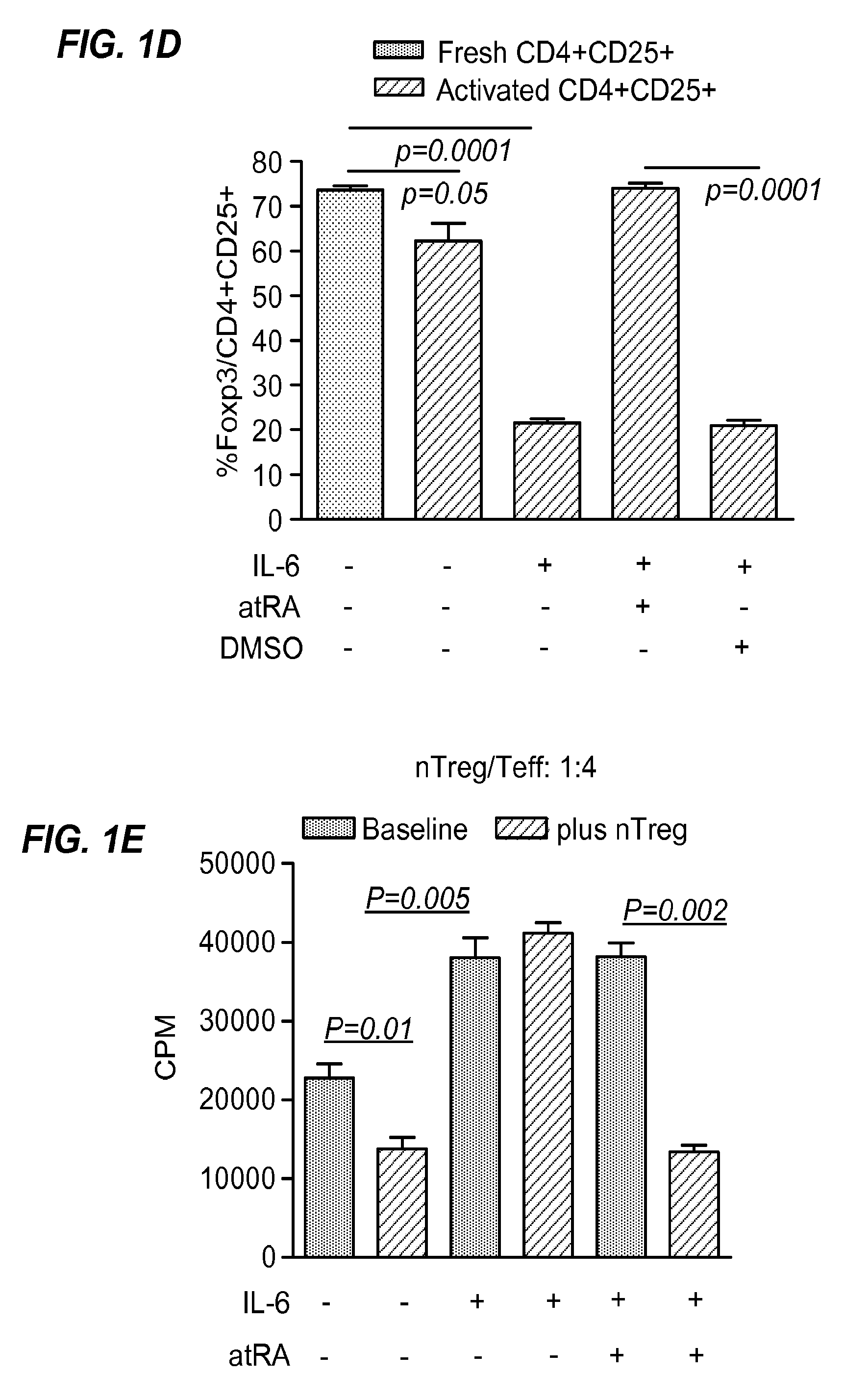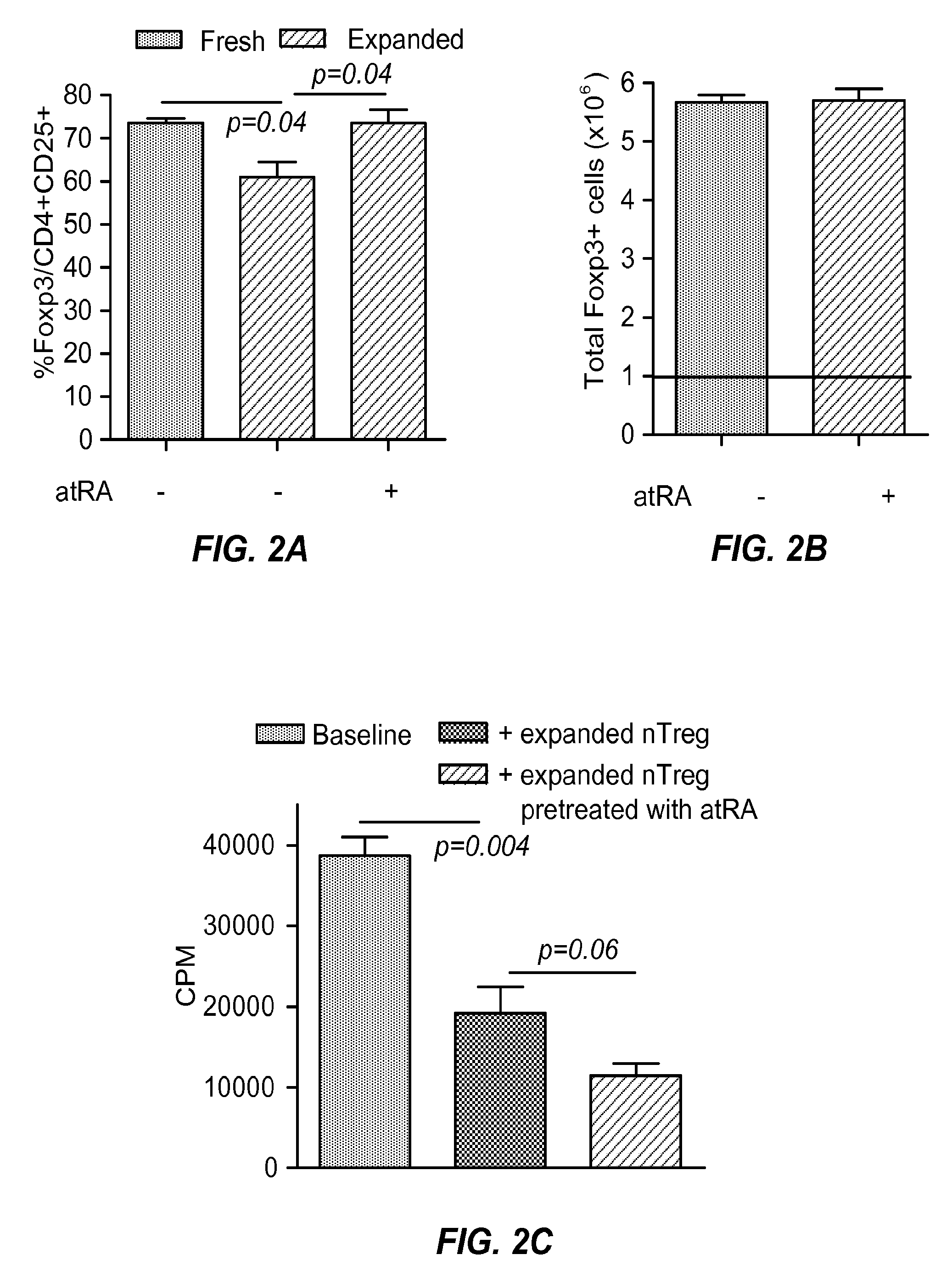Methods and compositions for expanding and stabilizing natural regulatory T cells
a natural regulatory t cell and composition technology, applied in the direction of drug compositions, immunological disorders, biocide, etc., can solve the problem of less predictable effect of transferring ntregs once a disease is established, and achieve the effect of stabilizing the phenotype of ntregs
- Summary
- Abstract
- Description
- Claims
- Application Information
AI Technical Summary
Benefits of technology
Problems solved by technology
Method used
Image
Examples
example 1
Cell Purification, In Vitro Cell Stimulation and Suppressor Assay
[0074]nTreg cells were sorted from thymus of DBA / 1 or Foxp3gfp knock-in DBA / 1 mice by gating on CD4+CD25+ or CD4+GFP+ cells. Cell populations were sorted to >99% purity.
[0075]To activate nTregs, CD25+ or GFP+ cells were stimulated with anti-CD3 / CD28 coated beads (1:5, one bead to five cells), rmIL-2 (100 U / ml) (R&D) with DMSO or all-trans retinoic acid (atRA, 0.05 μM) for 3 days. To generate Th17 cells, these activated nTregs were stimulated with immobilized anti-CD3 (1 μg / ml), soluble anti-CD28 (1 μg / ml), anti-IL-4 (10 μg / ml) (BD biosciences), anti-IFN-γ and IL-6 (10 ng / ml) (BD Pharmingen) for 3 days.
[0076]To measure suppressive activities, responder T cells were stimulated with soluble anti-CD3 (0.025 μg / ml) and irradiated APC (1:1), nTregs pretreated with at-RA or without atRA were added to cultures at a ratio of 1:4 (one nTreg to four responder cells). After 72-hour cultures, triplicate wells were pulsed with 1 μCi...
example 2
Treatment of nTregs with atRA Stabilizes Phenotype by Rendering nTregs Resistant to Th17 Conversion and Sustaining FOXP3 Expression
[0077]Naive CD4+CD25+CD62L+ nTregs sorted from the thymus of DBA / 1 mice were stimulated with anti-CD3 / CD28 antibodies with or without IL-6. nTregs TCR activated with IL-6 have been shown to become Th17 cells. FIG. 1A-C show, however, that when atRA was added to cultures containing IL-6 both intracellular IL-17 and soluble IL-17 production was completely blocked. Because atRA was dissolved in DMSO, similar volumes of DMSO was added to the cultures to exclude the possibility that atRA has a non-specific toxic effect on T cells (FIGS. 1A and B). For the data in FIGS. 1A and B, CD4+CD25+ cells were stimulated with immobilized anti-CD3 (1 μg / ml), soluble anti-CD28 (1 μg / ml) and IL-6 (10 ng / ml) with or without atRA (0.05 μM). 3 days later, these cells were restimulated with PMA (0.25 μg / ml) and ionomycin (0.25 μg / ml) for 5 h and brefeldin A (5 μg / ml) for 4 h, ...
example 3
nTregs Expanded with atRA are Resistant to the Inhibitory Effects of IL-6 on nTregs and Prevent Th17 Conversion
[0082]Natural Tregs expanded ten-fold in one week after stimulation with anti-CD3 / 28 coated beads with IL-2 and addition of atRA to the culture slightly decreased the expansion of nTregs (eight-fold). Unlike nTregs expanded with IL-2 only where FOXP3 expression gradually decreased, FOXP3 expressed by nTregs expanded with atRA remained stable and the suppressive activities of these cells were even superior than nTregs expanded without atRA (FIGS. 2A and B), which is consistent with reports that suppressive activity of Treg cells is closely associated with the expressive levels of FOXP3. For the data in FIGS. 2A and B, CD4+CD25+ cells were stimulated with anti-CD3 / CD28 coated beads (1:5), rmIL-2 (100 U / ml) with DMSO or atRA (0.05 μM) for 7 days and the FOXP3 expression (A) and total Foxp3+ cell numbers (B) were determined.
[0083]As shown in FIG. 2D, when nTregs expanded withou...
PUM
| Property | Measurement | Unit |
|---|---|---|
| concentration | aaaaa | aaaaa |
| concentration | aaaaa | aaaaa |
| concentration | aaaaa | aaaaa |
Abstract
Description
Claims
Application Information
 Login to View More
Login to View More - R&D
- Intellectual Property
- Life Sciences
- Materials
- Tech Scout
- Unparalleled Data Quality
- Higher Quality Content
- 60% Fewer Hallucinations
Browse by: Latest US Patents, China's latest patents, Technical Efficacy Thesaurus, Application Domain, Technology Topic, Popular Technical Reports.
© 2025 PatSnap. All rights reserved.Legal|Privacy policy|Modern Slavery Act Transparency Statement|Sitemap|About US| Contact US: help@patsnap.com



